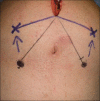Handling difficult anastomosis. Tips and tricks in obese patients and narrow pelvis
- PMID: 25378824
- PMCID: PMC4220382
- DOI: 10.4103/0970-1591.142070
Handling difficult anastomosis. Tips and tricks in obese patients and narrow pelvis
Abstract
Vesico-urethral anastomosis (VUA) is a technically challenging step in robotic-assisted laparoscopic prostatectomy (RALP) in obese individuals. We describe technical modifications to facilitate VUA encountered in obese individuals and in patients with a narrow pelvis. A Pubmed literature search was performed between 2000 and 2012 to review all articles related to RALP, obesity and VUA for evaluation of technique, complications and outcomes of VUA in obese individuals. In addition to the technical modifications described in the literature, we describe our own experience to encounter the technical challenges induced by obesity and narrow pelvis. In obese patients, technical modifications like use of air seal trocar technology, steep Trendlenburg positioning, bariatric trocars, alterations in trocar placement, barbed suture and use of modified posterior reconstruction facilitate VUA in robotic-assisted radical prostatectomy. The dexterity of the robot and the technical modifications help to perform the VUA in challenging patients with lesser difficulty. The experience of the surgeon is a critical factor in outcomes in these technically challenging patients, and obese individuals are best avoided during the initial phase of the learning curve.
Keywords: Robotic prostatectomy; obesity; prostate cancer; vesico-urethral anastomosis.
Conflict of interest statement
Figures
References
-
- Siegel R, Naishadham D, Jemal A. Cancer statistics, 2012. CA Cancer J Clin. 2012;62:10–29. - PubMed
-
- Bill-Axelson A, Holmberg L, Ruutu M, Garmo H, Stark JR, Busch C, et al. Radical prostatectomy versus watchful waiting in early prostate cancer. N Engl J Med. 2011;364:1708–17. - PubMed
-
- Froehner M, Litz R, Manseck A, Hakenberg OW, Leike S, Albrecht DM, et al. Relationship of comorbidity, age and perioperative complication in patients undergoing radical prostatectomy. Urol Int. 2001;67:283. - PubMed
-
- Tyritzis SI, Katafigiotis I, Constantinides CA. All you need to know about urethrovesical anastomotic urinary leakage following radical prostatectomy. J Urol. 2012;188:369–76. - PubMed
-
- Badani KK, Hemal AK, Peabody JO, Menon M. Robotic radical prostatectomy: The Vattikuti Urology Institute training experience. World J Urol. 2006;24:148–51. - PubMed
LinkOut - more resources
Full Text Sources
Other Literature Sources


